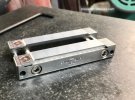- Joined
- Nov 15, 2005
- Messages
- 1,218
I recently got a Bruce Bump file guide.... primarily for filing in shoulders. However, I wanted to give a go at using a file guide on the grinder for keeping plunges lined up. I've seen a bunch of people do this. I had a heck of a time getting it to work. I tried an overhang with a J-Flex belt, but was having a hard time getting the belt to bend the way I envisioned.
I was wondering if any of yall routinely use these guides when grinding and if you had any specific tips (belt selection, over hang distance, speed, technique, etc)
Cheers,
JK

 www.brianbump.com
www.brianbump.com

I was wondering if any of yall routinely use these guides when grinding and if you had any specific tips (belt selection, over hang distance, speed, technique, etc)
Cheers,
JK

Available Now! New Stainless Steel File Guides With Adjustable Carbides. Please Contact Bruce to get on our mailing list for first contact! — Bruce Bump
Made in the U.S.A. These workhorses feature CNC precision machined stainless steel body with fully adjustable and removable large surface carbide blank inserts. Hand assembled and finished in Walla Walla, Washington in small batches, a limited supply. We ship priority in USA. International orders


